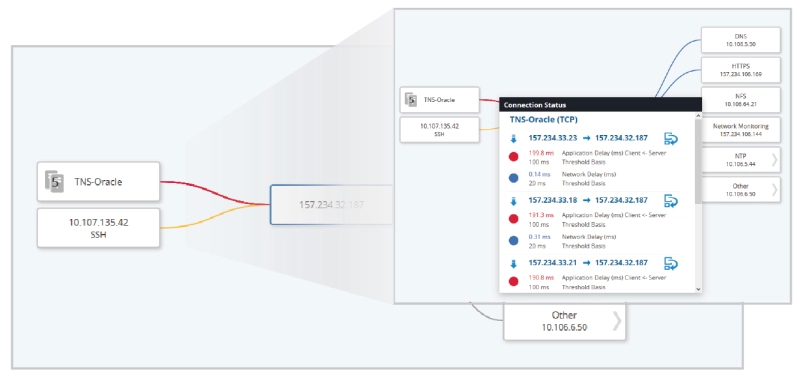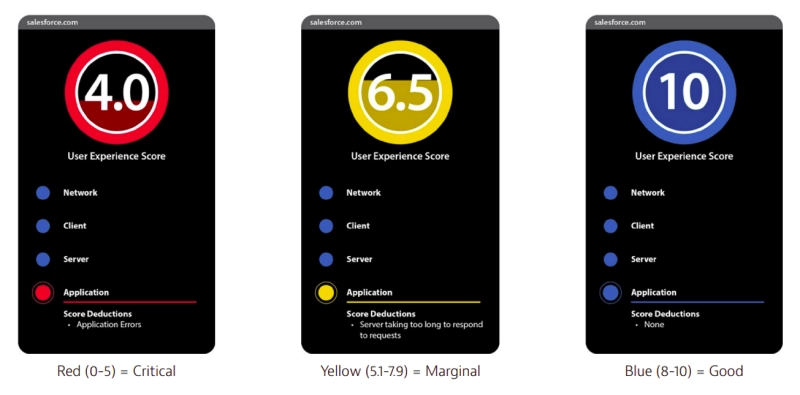What is End-User Experience Monitoring?
Uncover the world of end-user experience monitoring in this comprehensive guide. Learn why it's vital for IT teams to proactively measure user satisfaction.
EUE monitoring is used to measure and prioritize network data based on the quality of experience delivered to users. Rather than relying on direct client feedback to identify disruptions, delays, or application performance problems, end-user experience monitoring leverages improved visibility and analysis of performance indicators to proactively detect regressions.
- End-user experience scoring is used to quantify performance on a numeric scale and establish response thresholds. The EUE scores are weighted based on underlying algorithms and the relative importance of the contributing KPI’s. Aggregate EUE scores assess sites, application, servers, and/or a combination of the three. Individual client-based EUE scores characterize the experience of a single user.
- Patented VIAVI EUE scoring is derived from 30+ KPI’s distilled down by Observer Apex into a simple color-coded score ranging from 1-10. Machine learning is used to characterize unique environmental and application factors for each network conversation to make the scoring more accurate and actionable. The EUE score is presented with the problem domain (network, client, server, or application) identified along with a list of the most impactful issues within the identified problem domain.

Why is End-User Experience Monitoring Important?
Each major IT fixing organization has experts equipped with the tools they need to monitor their domain and area of expertise. Application and network architectures have become much more complex over time. When you add work from home (WFH), private cloud, hybrid cloud, and software as a service (SaaS) to the mix expertise is no longer enough. The expert teams review their problem domains, but no one is watching the entire end-to-end transaction from the end user’s perspective. Focusing on end-user experience FIRST as the ultimate barometer of application and network performance as perceived by the users immediately identifies which fixing organization needs to address the problem.
- “IT overload” is a term used to describe the growing problem of Tier 1 support teams being overwhelmed by tickets with no clear path to resolution. End-user experience scoring and dashboards reveal the scope, impact, and problem domain of performance issues easily so that they can be routed to the proper fixing organization efficiently. This approach allows more problems to be detected and prevented before impacting the end user.
- Issue prioritization helps to ease the burden on IT teams. Color-coded EUE scores highlight the most impactful performance issues along with the problem domain. Application Dependency Mapping (ADM) in VIAVI Observer Apex automatically displays a graphical application dependency mapping of complex multi-tier applications overlaying the EUE score between each dependency. This improves IT efficiency and lost productivity by accelerating mean time to repair (MTTR).

- IT skills gaps become more prevalent as network complexity moves beyond the understanding of less experienced IT professionals. Rather than burdening IT teams with hundreds of KPIs not directly linked to the end user’s experience, end-user experience monitoring tools produce a single, intuitive KPI that is easily understood by all skill levels and lessens the burden on experienced IT experts.
Ensuring the quality of the end-user experience has become a top priority for IT teams in a wide range of industries. The use cases benefiting from robust end user application monitoring continue to expand as network and user locations diversify.
- Financial Services: As financial services migrate to the cloud and mobile banking apps become the standard, customers rely on secure, low latency transactions and efficient data transfers. End-user experience monitoring quickly identifies sites, users, or applications that are experiencing slowdowns or outages and provides the tools needed to support performance baselining and threat hunting activities.
- Healthcare Organizations: IT teams must secure sensitive patient information while providing seamless 24/7 network availability. End-user experience monitoring supports these priorities by preventing performance issues before patients or providers are impacted and providing unmatched access to forensic data to mitigate security incidents.
- Manufacturing: Downtime in a manufacturing environment equates to lost productivity and is a competitive disadvantage. When network delays or outages do occur, it is important to know exactly who is impacted, and how. End-user experience monitoring is a valuable tool for determining the root cause of issues quickly to minimize the impact on production.
- Network Capacity Planning: Network utilization and traffic must be reviewed continually to determine when bandwidth upgrades are warranted. Insightful capacity planning should consider the performance of existing services from the user’s perspective. The End-User experience monitoring and capacity planning dashboards of the Observer Apex platform quickly identify network problem domain issues such as latency and jitter that can degrade the quality of services like VoIP and video streaming.
- Work From Home (WFH): Today’s networks were not intended to support thousands of employees working from home or off-site locations. End-user experience monitoring increases observability into conversation paths between WFH and off-site users and the centralized network, maps application dependencies, and ensures WFH and off-site workers remain productive.
- VPN Monitoring: As a byproduct of WFH and off-site work, virtual private network (VPN) usage is increasing at an unprecedented rate. With VPN oversubscription becoming a leading cause of network disruption for remote employees, the monitoring of VPN traffic is critical. EUE monitoring allows operators to gain deeper insight into VPN tunnel performance along with the quality of delivered applications.
Deciding how to utilize the advanced tools, methods, and data sources available for end-user experience monitoring can be a daunting task. Here are some industry best practices to help guide you:
-
Set meaningful alerts: Rather than set alarms and alerts for hundreds of KPI’s, (leading to alert fatigue), consider alerting only on degraded or degrading EUE scores. If your end-user experience monitoring solution is doing its job, it will be the problem domain “divining rod” quickly pointing to where IT teams should focus their attention.
-
Analyze multiple locations: End-user experience may vary depending on geographic location. For example, the EUE score for a particular application at one site may vary from different users at different site. Analyzing EUE scores from multiple locations provides a holistic approach that clearly identifies the impact of users, the network, and the individual applications.
-
Use a consistent scoring method: EUE scoring systems can only be effective when the score itself conveys meaning with little additional explanation needed. Consistent scoring methods include replicating the same range of EUE scoring values consistently. Color coding can also be useful for associating scores with levels of urgency.
.
End-user experience monitoring solutions help to make the complex simple by automatically distilling down a series of KPI’s into actionable intelligence that improves your user’s experience. Satisfied users, reduced ticket counts, and intuitive troubleshooting workflows benefit IT teams and the overall business.
- Focus on the end-user: A shift in focus to the end-user for monitoring solutions puts the attention where it belongs. Collecting and analyzing data from the end-user’s perspective allows IT teams to act on real-time customer feedback without bothersome polls, surveys, or complaints.
- Solve problems faster: End-user experience monitoring tools make it easier to quickly isolate problems to a specific domain (network, client, server, or application) based on individual domain scoring. This insight improves mean time to resolution (MTTR) and mean time to innocence (MTTI) to quickly determine which IT team owns the problem.
- Measure the impact of change: Many companies are taking on major IT initiatives like data center consolidation and migrating to the cloud. Measuring the end-user experience BEFORE and AFTER a major network architecture change provides businesses with the feedback they need to understand the financial impacts and productivity gain (or loss) achieved.
- Increase capital expenditure ROI: When end-user experience is unacceptable or needs to be improved, how do IT teams know which capital expenditure would be the most beneficial? Should they pay to increase network bandwidth? Are adding more servers the answer? How about improving an inefficient application? By analyzing the EUE scores and problem domains IT teams can quickly determine where to best spend time and capital to improve the end user’s experience.

